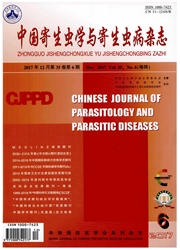

 中文摘要:
中文摘要:
目的 分析云南省输入性及本地感染间日疟病例的疟原虫裂殖子表面蛋白1(Plasmodium vivax merozoite surface protein-1, PvMSP-1)基因5区序列及其等位基因的多态性。 方法 2012年8月-2015年9月,收集云南省输入性及本地感染间日疟病例的滤纸血样和流行病学史等相关信息。提取疟原虫DNA, PCR扩增PvMSP-1基因5区并测序,与M75674、AAN86237、M60807、ABJ53045、AAN86238、BAA18977等参比序列进行比对,用Mega 5.04、Arlequin3.5.1软件分析PvMSP-1基因5区的序列多态性,计算序列间保守位点、遗传距离和多样性指数,并根据氨基酸序列间的遗传距离绘制聚类树状图。 结果 2012年8月-2015年9月,共收集间日疟病例血样847份。其中,云南省本地感染61份,非洲、缅甸感染的分别为66和720份。847份血样中278份扩增出PvMSP-1基因5区片段,206份测序成功。PvMSP-1基因5区片段编码氨基酸长193~222 aa。氨基酸序列比对分析显示,Sal-1、Belem和Recombine基因型分别占59.2%(122/206)、23.3%(48/206)和17.5%(36/206),缅甸、非洲感染和云南本地感染血样中Sal-1基因型分别占58.8%(104/177)、11/15和7/14。Sal-1、Belem、Recombine基因型分别有51、9和6个亚型。这66个亚型的Shannon-wiener指数(H’)和期望杂合度(He)分别为0.955和0.567。206条DNA序列的同源位点为665 bp、保守位点为11.3%(75/665)、变异位点为88.7%(590/665),不同感染来源地的分离株与不同的氨基酸参比序列的遗传距离均小于0.4。聚类分析显示,206条PvMSP-1基因5区氨基酸序列按基因型聚类成2个大类,有3个次级分支,其中,Recombine与Belem基因型的相似度为91%~92%,高于与Sal-1基因型的82%~83%。 结论 云南省输入性及本地感染的间日疟原虫分离株PvMSP-1基因5区存在多种亚型,在Sal-1、Belem、Recombine等3种基因型中,Sal-1型占优势。
 英文摘要:
英文摘要:
Objective To analyze the sequence of Plasmodium vivax merozoite surface protein-1(PvMSP-1) and allele polymorphism in imported and local vivax malaria parasites in Yunnan Province. Methods Blood samples on filter paper were collected from imported and local vivax malaria cases in Yunnan Province during August 2012 and September 2015 and information of epidemiological history was recorded. Plasmodium DNA was extracted by a DNA extraction kit, and the block 5 region in PvMSP-1 gene was amplified by PCR. The PCR products were sequenced and blasted with reference sequences M75674, AAN86237, M60807, ABJ53045, AAN86238 and BAA18977. The sequence polymorphism in block 5 region of PvMSP-1 was analyzed with MEGA 5.04 and Arlequin3.5.1 softwares. The conserved sites, genetic distances among sequences and Shannon-wiener index among alleles were calculated. The clustering tree was drawn according to the genetic distances between the amino-acid sequences. Results A total of 847 blood samples were collected from the malaria cases, comprising of 61 samples from local cases, 66 from imported cases from Africa, and 720 from Myanmar. The block 5 region in PvMSP-1 was successfully amplified in 278 samples, and sequencing was successfully made in 206 of them. The peptide coded by the block 5 region had a length of 193 to 222 aa. The amino acid sequence alignment showed that in 206 samples the proportion of genotypes of Sal-1, Belem and Recombine was 59.2%(122/206),23.3%(48/206) and 17.5%(36/206), respectively. The proportion of Sal-1 genotype in imported cases from Myanmar and Africa and in local cases was 58.8%(104/177),73.3%(11/15) and 50%(7/14), respectively. The genotypes Sal-1, Belem and Recombine had 51, 9 and 6 different alleles. The 66 alleles had a Shannon Wiener index (H’) of 0.955 and an expected heterozygosis (He) of 0.567. The 206 DNA sequences had a 665-bp homologous locus, comprising of 75 conserved sites (11.3%,75/665) and 590 variable sites (88.7%, 590/665). The genetic
 同期刊论文项目
同期刊论文项目
 同项目期刊论文
同项目期刊论文
 期刊信息
期刊信息
